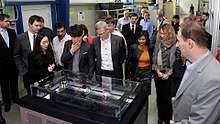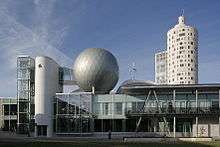Science museum
A science museum is a museum devoted primarily to science. Older science museums tended to concentrate on static displays of objects related to natural history, paleontology, geology, industry and industrial machinery, etc. Modern trends in museology have broadened the range of subject matter and introduced many interactive exhibits. Many if not most modern science museums – which increasingly refer to themselves as science centres or "discovery centres" – also emphasize technology, and are therefore also technology museums.

The mission statements of science centres and modern museums vary, but they are commonly places that make science accessible and encourage the excitement of discovery.
Museum of Jurassic Technology, Introduction & Background, p. 2
History
As early as the Renaissance, many aristocrats collected curiosities for display to their family. Universities and particularly medical schools also maintained study collections of specimens for their students. Scientists and collectors displayed their finds in private cabinets of curiosities. Such collections were the predecessors of modern natural history museums.
The first purpose-built museum covering natural philosophy and open to the public from 1683 was the original Ashmolean museum (now called the Museum of the History of Science) in Oxford, although its scope was mixed.[1] The first dedicated science museum was the Museo de Ciencias Naturales, in Madrid, Spain. Opened in 1752, it almost disappeared in Francoist Spain, but it recovered afterwards and today works closely with the CSIC.[2] The Utrecht University Museum, among others, still displays an extensive collection of 18th-century animal and human "rarities" in its original setting.
Another line in the genealogy of science museums came during the Industrial Revolution, with great national exhibits intended to showcase the triumphs of both science and industry. For example, the Great Exhibition in The Crystal Palace (1851) eventually gave rise to London's Science Museum.
In America, various Natural History Societies established collections in the early 19th century, which evolved into museums. Notable was the early New England Museum of Natural History, (now the Museum of Science) which opened in Boston in 1864. The Academy of Science of Saint Louis was founded in 1856 as the first scientific organization west of the Mississippi (although the organization managed scientific collections for several decades a formal museum was not created until the mid-20th century).
Modern science museums
.jpg)
The modern interactive science museum appears to have been pioneered by Munich’s Deutsches Museum in the early 20th century. This museum had moving exhibits where visitors were encouraged to push buttons and work levers. The concept was taken to the US by Julius Rosenwald, chairman of Sears, Roebuck and Company, who visited the Deutsches Museum with his young son in 1911. He was so-captivated by the experience that he decided to build a similar museum in his home town. Chicago's Museum of Science and Industry opened in phases between 1933 and 1940.
In 1959 the Museum of Science and Natural History (now the Saint Louis Science Center) was formally created by the Academy of Science of Saint Louis, featuring many interactive science and history exhibits.
In August 1969, Frank Oppenheimer dedicated his new Exploratorium in San Francisco almost completely to interactive science exhibits. The Exploratorium published the details of their own exhibits in "Cookbooks" that served as an inspiration to many other museums around the world.
Opened in September 1969, the Ontario Science Centre continued the trend of featuring interactive exhibits rather than static displays.
In 1973, the first Omnimax cinema opened as the Reuben H. Fleet Space Theater and Science Center in San Diego's Balboa Park. The tilted-dome Space Theater doubled as a planetarium. The Science Center was an Exploratorium-style museum included as a small part of the complex. This combination interactive science museum, planetarium and Omnimax theater pioneered a configuration that many major science museums follow.

Also in 1973, the Association of Science-Technology Centers (ASTC) was founded as an international organization to provide a collective voice, professional support, and programming opportunities for science centres, museums and related institutions.
The massive Cite des Sciences et de l'Industrie opened in Paris in 1986, and national centres soon followed in Spain, Finland, and Denmark. In the UK, the first interactive centres also opened in 1986 on a modest scale, with further more than a decade later when funded by the National Lottery for projects to celebrate the millennium.
Since the 1990s, science museums and centres, such as Thailand's National Science Museum, have been created or greatly expanded in Asia.

Science centre

Museums that brand themselves as science centres emphasize a hands-on approach, featuring interactive exhibits that encourage visitors to experiment and explore.
The first science centre was Urania founded in Berlin in 1888.[3][4] The Academy of Science of Saint Louis (founded in 1856) created the Saint Louis Museum of Science and Natural History in 1959 (Saint Louis Science Center), but generally science centres are a product of the 1960s and later. In the United Kingdom, many of them were founded as Millennium projects, with funding from the National Lotteries Fund.
The first "science centre" in the United States was the Science Center of Pinellas County, founded in 1959. The Pacific Science Center (one of the first large organizations to call itself a "science centre" rather than a museum) opened in a Seattle World's Fair building in 1962. The Smithsonian Institution invited visitors into a new Discovery Room in its National Museum of Natural History in Washington, D.C., where they could touch and handle formerly off-limits specimens. In 1969, Oppenheimer's Exploratorium opened in San Francisco, California, and the Ontario Science Centre opened near Toronto, Ontario, Canada. By the early 1970s, COSI Columbus, then known as the Center of Science and Industry in Columbus, Ohio, had run its first "camp-in."
It did not take long for these new-style museums to band together for mutual support. In 1971, 16 museum directors gathered to discuss the possibility of starting a new association – one more specifically tailored to their needs than the existing American Association of Museums (now the American Alliance of Museums). The Association of Science-Technology Centers (ASTC) was formally established in 1973, headquartered in Washington DC, but with an international organizational membership. The corresponding European organization is ECSITE and in the UK the Association of Science and Discovery Centres (ASDC) represent the interests of science engagement organisations.[5]
In India, the National Council of Science Museums runs science centres at several places including Delhi, Bhopal, Nagpur and Ranchi. There are few private Science Centres as well, noted among them are Birla Science Museum and The Science Garage in Hyderabad.[6]
See also
References
- Fox, Robert (January 2006). "The history of science, medicine and technology at Oxford". Notes and Records of the Royal Society. 60 (1): 69–83. doi:10.1098/rsnr.2005.0129. PMID 17153170.
- El Museo de Ciencias Naturales alerta de su 'colapso por falta de espacio' | elmundo.es
- "Deutsches Technikmuseum Berlin".
- "Ecsite - European Network of Science Centers and Museums".
- "About". 2017-06-08.
- "The Science Garage". The Science Garage. Retrieved 15 February 2015.
- Kaushik, R.,1996, "Effectiveness of Indian science centres as learning environments : a study of educational objectives in the design of museum experiences", Unpublished PhD thesis, University of Leicester, UK
- Kaushik, R.,1996, "Non-science-adult-visitors in science centres: what is there for them to do?", Museological Review, Vol. 2, No. 1, p. 72–84.
- Kaushik, R.,1996, "Health matters in science museums: a review" in Pearce, S. (ed.) New Research in Museum Studies, Vol. 6, Athlone Press, London/Atlantic Highlands, p. 186–193.
- Kaushik, R.,1997, "Attitude development in science museums/centres", in Proceedings of the Nova Scotian Institute of Science, Vol. 40, No. 2, p. 1–12.
Further reading
- "Museums of Science", Encyclopædia Britannica (11th ed.), New York: Encyclopædia Britannica Co., 1910, OCLC 14782424
External links
| Wikimedia Commons has media related to Science museums. |
